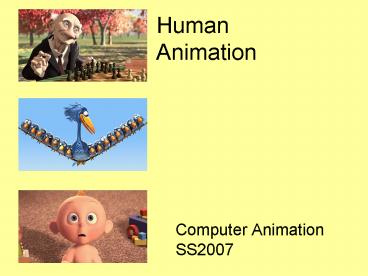Human Animation - PowerPoint PPT Presentation
1 / 29
Title:
Human Animation
Description:
Lips Toward. Orbicularis Oris Each Other. Nose Wrinkler. Levator Labii Superioris, Alaeque Nasi ... Lip-Syncing. Motion capture. Dots are placed at key points ... – PowerPoint PPT presentation
Number of Views:86
Avg rating:3.0/5.0
Title: Human Animation
1
Human Animation
- Computer Animation SS2007
2
What is a character?
3
3-D Character Animation
- The use of computer graphics to create
three-dimensional characters - Like 2-D animation, relies on a knowledge of
acting - Unlike 2-D animation,requires a sense of 3-D
space
4
Character design
- 3-D modeling
- Articulated figures
- Skin
- Hair
- Clothing
- Facial expressions
- Acting Emotions
5
Facial Modeling
- Body components are modeled using spline meshes
- Splines (bi-cubic paramterized equations) capture
the curvature of surfaces
6
The Basic Technique
7
Create a Flat Mask
- Images can be used as templates for designing a
character - This is called rotoscoping
- Note how more curves are included for eye sockets
and mouth - This is only done for half of the face
8
Add Depth
- Once a flat, 2-D mesh is created using a front
view image, various points can be raised to add
depth - This is called lofting
- At this stage, additional control pints and edges
can be added
9
Extend Arcs to Back
- Once this mask has been created, various curves
are extended to form the back of the head - Additional curves are added, to complete the
heads mesh - But we still only have half of a head
10
Copy, Flip Attach
- Once a half head has been created, a copy is made
- This copy is then flipped along the X-axis
(mirrored) and attached to the original half
11
Creating the Body
- Bodies are also often created by first modeling
one half, and then attaching a flipped copy
12
Articulated Figures
- Body parts are jointed (articulated) to form a
hierarchy
Body
Torso
Hips
Upper Left Leg
Upper Right Leg
Upper Left Arm
Upper Right Arm
Lower Left Leg
Lower Right Leg
Lower Left Arm
Lower Right Arm
Left Foot
Right Foot
Left Hand
Right Hand
Neck
Head
13
Boning
- Once a models geometry has been created, bones
are added - Bones allow an animator to control various body
parts directly - Bones are often connected via joints
14
Degrees of Freedom
- Joints have degrees of freedoms (DoF)?
- Rotational
- Translational
- Scaling
- Limits (constraints) can be applied to each DoF
to insure believable or acceptable motions
15
Rigging
- Each bone is associated with one or more control
points - Each control point can only be associated with
one bone - This is called rigging
16
Skin
- Real skin is translucent
- Light is scattered through the various layers,
and reflected from a sub-layer - Bidirectional reflectance distribution
functions(BRDF) are often used
BRDF
No BRDF
17
Hair
- Difficult to model
- Techniques
- Individual hairs
- Hairs groups (clumps)?
- Particles
- Surface with texture mapping
18
Clothing
- Difficult to model
- May require physical model
- Techniques
- Surfaces with texture mapping
- Individual threads
- Others
19
Facial Expressions
- Facial Action Coding System
- Points on face are keyed to underlying muscles
20
Facial Expressions
- Inner Brow RaiserFrontalis, Pars Medialis
- Outer Brow RaiserFrontalis, Pars Lateralis
- Brow Lowerer Depressor Glabellae Depressor
Supercilli Corrugator - Upper Lid Raiser Levator Palebrae Superioris
- Cheek Raiser Orbicularis Oculi, Pars Orbitalis
- Lid Tightener Orbicularis Oculi, Pars Palebralis
- Lips Toward Orbicularis Oris Each Other
- Nose Wrinkler Levator Labii Superioris, Alaeque
Nasi - Upper Lip Raiser Levator Labii Superioris, Caput
Infraorbitalis
21
Acting Emotions
- Emotions
- Lip-syncing
- Body movement
22
Emotions
- Which is
- Happy
- Surprise
- Anger
- Disgust
- Curiosity
- Note direction of movement due to muscles
23
Lip-Syncing
- Motion capture
- Dots are placed at key points on actors face
- As actor speaks, dots are tracked and positions
recorded
24
Phonemes
- Mouth orientation based on vocal sounds
- Note sound groupings
25
Body movement
- Synthetic motions
- Motion capture
26
Synthetic Motions
- Uses either physics or simulations
- Difficult to replicate nuances of human motion
- Often requires exaggeration to compensate
27
Motion Capture
- Actors wear either markers or actuators to record
either positional or rotational data,
respectively - Also called performance capture
28
And now our feature presentations!
29
The Future
- Will 3-D character animation yield synthetic
actors indistinguishable from live actors? - What else is possible?

